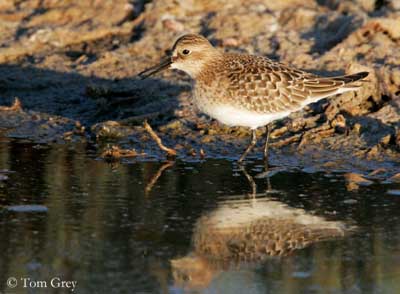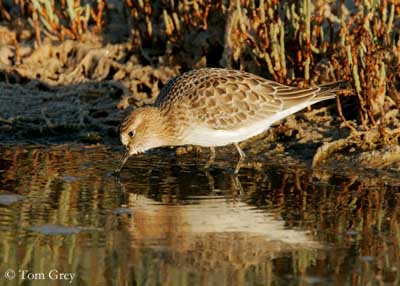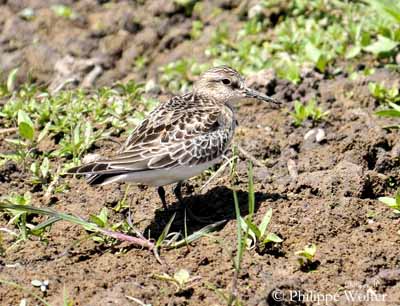
PROTECTION / THREATS / STATUS:
The Baird’s Sandpiper’s populations are currently stable. The threat will probably come from the degradation or the destruction of the habitat, but at this time, this species is not threatened.
Ang : Baird’s Sandpiper
All : Bairdstrandläufer
Esp : Correlimos de Baird
Ital : Gambecchio di Baird
Nd : Baird-strandloper
Sd : Gulbröstad snäppa
Port: Maçarico-de-bico-fino
Photographers:
Aurélien Audevard
OUESSANT DIGISCOPING
Tom Grey
Tom Grey's Bird Pictures
Philippe et Aline Wolfer
OISEAUX D’ARGENTINE
Text by Nicole Bouglouan
Sources:
HANDBOOK OF THE BIRDS OF THE WORLD Volume 3 by Josep del Hoyo-Andrew Elliott-Jordi Sargatal - Lynx Edicions - ISBN : 8487334202
A GUIDE TO THE BIRDS OF MEXICO AND NORTHERN CENTRAL AMERICA by Steve N. G. Howell, Sophie Webb - Oxford University Press - ISBN: 0198540124
GUIDE DES LIMICOLES de D. Taylor - Delachaux et Niestlé - ISBN : 2603014080
SHOREBIRDS by Peter Hayman, John Marchant and Tony Prater – Christopher Helm – 1986 – ISBN: 0747014035
All About Birds (Cornell Lab of Ornithology)
What Bird-The ultimate Bird Guide (Mitchell Waite)
Bird Web (Seattle Audubon Society)
Baird’s Sandpiper
Calidris bairdii
Charadriiforme Order – Scolopacidae Family
BIOMETRICS:
Length: 14-17 cm
Wingspan: 40-46 cm
Weight: 32-63 g
DESCRIPTION:
The Baird’s Sandpiper has long wings and short legs.
In breeding plumage, the upperparts are black-brown on crown, nape, mantle and scapulars. Rump and uppertail are dark.
The profile appears long, due to the elongated primary flight feathers.
On the underparts, the breast is buff with brown streaks. Belly, flanks and undertail coverts are white. Underwing-coverts are whitish.
Head is dark brown streaked paler brown. We can see short buff supercilium. Lores are dark. Throat is whitish.
The black bill is short and thin. Legs and feet are black. Eyes are dark brown.
The winter plumage is softer, dull greyish above.
Both sexes are similar.

The juvenile has fringed buffish or buff-white upperparts, giving scaled effect. Head and breast are washed buffy with brown streaks. Belly and flanks are pure white as in adults.

VOICE: SOUNDS BY XENO-CANTO
The Baird’s Sandpiper utters low “kriiip” or raucous “krrt”. The usual call is a soft, rolling ‘kirrp ».
The song is a guttural trilling given during the aerial displays.
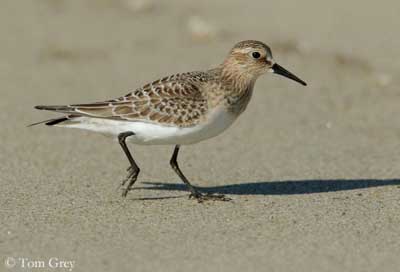
HABITAT:
The Baird’s Sandpiper frequents sandy beaches, marshes and wet edges, inland or coastal areas, rivers, lagoons, estuaries, salt-marshes and sandy areas with little vegetation.
RANGE:
This species breeds in high Arctic islands and adjacent tundra, from Canada to Alaska, N Siberia and NW Greenland.
It winters southwards in Central America and South America. It can be found in high Andes near alpine lakes and high grasslands, between 2500 and 4700 metres of elevation.
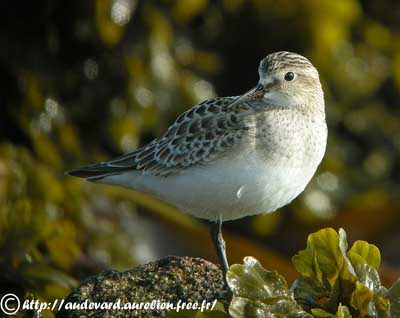
BEHAVIOUR:
To feed, the Baird’s Sandpiper runs fast on the ground with erect head, to catch insects and worms. It forages on the ground or at mud surface, and pecks with quick bill jabs instead to probe, running with other sandpipers along marshes in shallow water. It wades and submerges the head when feeding, and also can swim while pecking items from the surface.
During the fall, it forages among the debris on the beaches. This species is less gregarious than other Calidris species, but large flocks can form during the migrations.
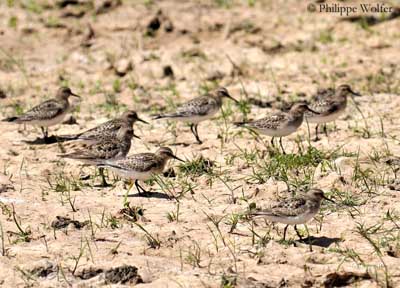
The Baird’s Sandpiper displays at “lek”, that is unusual in shorebirds. The male defends its small area by posturing and sometimes pecking at other males. The females visit the lek and can mate with one or several males. Some courtship behaviour can start during the spring migration. It also performs aerial displays.
The adults abandon the young as soon as their plumage allows them to fly and protects them against the bad weather. They become rapidly mature and can start their first migration one month later.
During the migration, the adults start from C North America, flying over 6500 kilometres to the South American grasslands. They travel above the mountains, often with other sandpiper species.
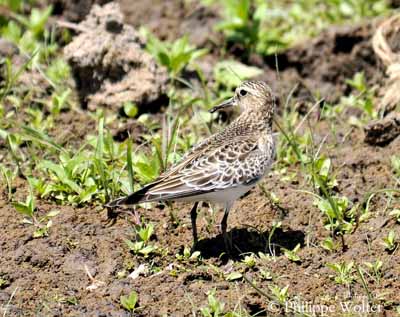
The Baird’s Sandpiper is often seen solitary or in small groups of 20-30 birds. When they are on their feeding grounds, some of them defend the area.
FLIGHT:
The Baird’s Sandpiper has agile and fast flight. It flies low and in small groups.
It performs strong flight thanks to the long wings.
REPRODUCTION:
The Baird’s Sandpiper is monogamous. It nests in moss or grass, among rocks, on bank or mound, in alpine or coastal tundra. The nest is partially built by the male. That is a depression on the ground among the short vegetation, often sheltered by a clump of grass. The scrape is lined with lichens, grasses and leaves.
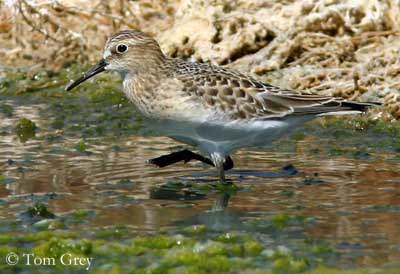
The laying occurs in June. The female lays 4 eggs, tinged chesnut-brown, at one day intervals. Incubation lasts three weeks, shared by both parents, but later, the male does most of the nesting duties. The young fledge and fly at 19-20 days of age.
As soon as they have their complete plumage, they do not need to be fed by the adults and their parents abandon them and start to migrate. Usually, the female leaves earlier than the male.
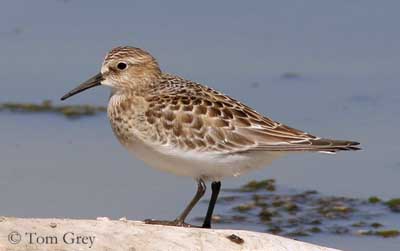
DIET:
The Baird’s Sandpiper feeds on insect larvae, beetles, grasshoppers and spiders, and also aquatic invertebrates, mainly during the nesting period.
During the migration, it consumes more larvae and adults of coleopterans and dipterans.
